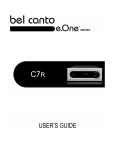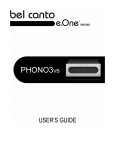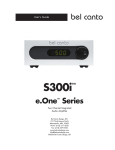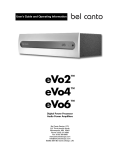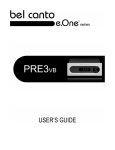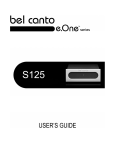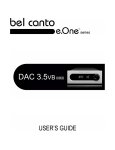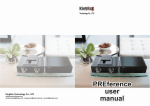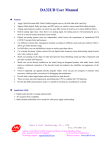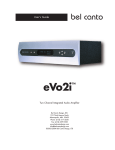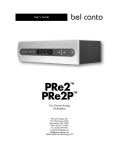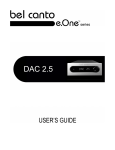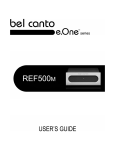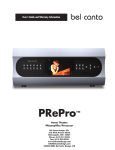Download Bel Canto Design SET 40 User`s guide
Transcript
Bel Canto Design PHONO 1 Low Noise Solid State Phono Preamplifier User's Guide and Operating Information Bel Canto Design • 212 Third Avenue North – Suite 345 • Minneapolis, MN 55401 Phone: (612) 317.4550 • Fax: (612) 359.9358 • Email: [email protected] Aug.2000 Low Noise Solid State Phono1 Preamplifier The Bel Canto Design’s PHONO1 components are selected for high sound quality, precision, technical virtue, and material quality. Bel Canto’s circuit designs and component quality will provide superb performance and years of listening satisfaction. Page 2 PHONO Owner's Manual Bel Canto Design grew from the quest to achieve the ultimate musical satisfaction from an audio system. This quest began with the discovery of the inherent sonic qualities and musical performance potential of a nearly forgotten technology, the single-ended triode amplifier. The ability of this type of amplifier to recreate the musical experience and evoke a powerful emotional response in the listener, much like the live event, inspired the development of the SET line of amplifiers through the ultimate expression of this technology. The SET circuit was developed for use as both a cornerstone for a modern audio system and as a reference tool to explore the reasons behind the single-ended triode amplifier's uniquely musical attributes. For more than ten years this effort has continued and the result is a unique line of fine audio amplifiers and preamplifier that are designed to embody the unparalleled musical reproduction of the single-ended triode architecture. Bel Canto Design's goal simply to provide the most expressive and powerful musical experience outside of the live event and bring some of the greatest musicians and their performances into the intimacy of your home. Bel Canto Design PHONO Owner's Manual Page 3 Design Features A classic architecture had been chosen to provide a firm foundation for the RIAA equalization and gain stages of the Phono1. The RIAA uses a robust series EQ architecture with high precision, low noise, high linearity resistors and high precision polypropylene film and foil construction capacitors for optimum signal transfer. The Moving Magnet gain is in the RIAA Equalization stage, using the latest ultra low distortion, low noise monolithic preamplifier device. This device combines extremely low distortion with low offset, noise and high output drive capability to be a transparent conduit for the musical signal. The high performance gain and equalization setting RC elements dominate the musical signature of this MM/EQ stage, leading to a detailed yet musical presentation. The MM/EQ stage provides 40 dB of 1kHz gain. The MC gain stage is connected optionally before the MM/EQ stage and provides extremely low noise and low distortion, again using high performance resistors for gain setting and adjustable input loading. The MC stage is connected into the circuit using gas tight gold jumpers, these jumpers also are used to set the MC stage gain at 14 or 20 dB. This provides up to 60 dB of 1 kHz gain for use with low output MC cartridges. The first stage of filtering drives eight (4) individual regulators providing power to the analog circuits, where audio grade electrolytic and film bypass capacitors complement the active regulation stages. A highly isolated power transformer, oversized by 10X provides extremely low-noise and robust raw power to feed the precision regulators. The input impedance, gain and relative noise levels can be optimized for virtually any cartridge available. This is achieved through the use of gas tight gold jumpers and precision miniature switches to simplify the optimization for virtually any cartridge. The elegant simplicity of the signal path allows the Phono1 to preserve the entire audio signal. Warm Up The Phono1's sonic performance will start to stabilize after approximately forty (40) hours of continuous power up. No coupling capacitors are used in the signal path, removing this source of signal degradation. A servo is used around the MM/EQ stage to insure low DC offset for direct coupling to the control preamplifier. There is over 10,000 uf of capacitance and LC high frequency filters providing the raw DC. Page 4 PHONO Owner's Manual Unpacking Unpacking dealer or Bel Canto Design. The box containing your Phono1 contains the following parts: Save all packing materials as the packing is specially designed to protect the preamplifier for shipping or transporting it. If you lose or damage the packing materials or carton, please contact your dealer or distributor before attempting to transport the preamplifier. 1 - Phono1 User's Guide 1 - Power Cable for connection to utility power [1.85m, 6' long] (External Box Version Only) 1 – Phono1 preamplifier 1 - Owner's Warranty / Registration Sheet Carefully your new unit and check for shipping damage. If there is any damage, or if any piece is missing, please contact your The Phono1's power supply is preset for the proper national voltages before you r eceive it. The power cable (External Unit Only) will have the proper plug for your local power system. If you believe this is not true, please contact your dealer immediately. Do not attempt to alter or change power settings yourself! Warning Do not connect power to this preamplifier yet! This preamplifier, like any electrical component, can be dangerous and cause injury unless cor rect handling procedures are observed and used. Before powering this preamplifier it is necessary to read and follow proper procedures concerning its setup and use. Any tampering of internal parts, other than for Moving Coil / Moving Magnet (MM/MC) setup, will immediately void your warranty. For Warranty Coverage complete and mail the Owner's Registration Papers immediately. PHONO Owner's Manual Page 5 Gain Settings, Initial Setup, and Placement • Gain Settings Internal jumpers accommodate Moving Magnet, Moving Coil (Low Gain), and Moving Coil (High Gain) settings. The Phono1 is shipped from the factory set for Moving Magnet operation. Gain structure changes are easily made by first removing the two gold nuts from the RCA output jacks using a 5/8” socket. Take care not to scratch the chassis by avoiding contact between the socket and the end panel. Next, remove the four stainless steel screws securing the opposite end panel with a 7/64” Allen tool. Carefully slide the circuit board partly out by slowly pulling on the input side end panel while securely holding the chassis. The circuit board only needs to be slid out part way to gain access to the internal jumpers. There are a total of 6 blue jumpers, which are labeled on the circuit board in the following locations: J7, J4, J6, J11, J3, and J5. They are easily removed by pulling them off of the 2-pin headers. When replacing the jumpers, be sure the jumper is oriented with the characters ‘3M’ at the top, otherwise the jumper may not function. MOVING MAGNET CARTRIDGE When using a Moving Magnet cartridge, the jumpers in locations J4, J6, J3, and J5 need to be placed in the positions labeled ‘MM’ (40dB of gain at 1kHz). The two remaining jumpers in locations J7 and J11 are inactive with this setting, and their positions are therefore irrelevant. MOVING COIL CARTRIDGE When using a Moving Coil cartridge, the jumpers in locations J4, J6, J3, and J5 need to be placed in the positions labeled ‘MC’. If low gain (54dB at 1 kHz) is desired, place the jumpers in locations J2 and J11 in the positions labeled ‘LOW’. If high gain (60dB at 1 kHz) is desired, place the jumpers in locations J2 and J11 in the positions labeled ‘HIGH’. Bel Canto recommends that you consult your turntable consultant / dealer to ascertain the exact setting to use with your particular system. Page 6 In the lack of specific system information the following can be used as a guide: - Use the Hi gain/MC setting when the output of your cartridge has less than .5mv output. - Use the Low gain/MC setting when your cartridge has more than .5mv output. When set for Moving Coil, the externally accessible loading DIP switches located between the input jacks are active. Loading options range from 50 Ohms to 50K Ohms, and right and left channels are adjustable independently. • Cartridge Loading Cartridge loading settings should directly correspond to the cartridge manufacturers recommended loading figure. If you don’t know the recommended loading of your cartridge, please contact the manufacturer or your dealer for this information. Loading settings can be done using the DIP switches seen through the opening near the RCA inputs of your phono stage. For the normal settings seen on the panel below the DIP switch opening use a pen or small pointed object to switch down the corresponding DIP switch. All other switches should be in the up position. Note: Changes to the DIP switch positions only apply when the MM/MC jumpers, located inside the Phono1, are in the Moving Coil (MC) position. Please refer to the following chart for a complete listing of loading settings possible to correctly match your cartridge: PHONO Owner's Manual DIP switch setting BLANK = UP, X = DOWN Cartridge 50 100 500 1 k 10 k Load(ohms) 50000 x 8333 x 980 x x 893 x 495 x x 472 x x 331 x x x 321 x 100 x x 99 x x 91 x x x 90 x x 83 x x x 77 x x x x 76 50 x x 48 x x x 47 x x 45 x x x 43 x x 33 x x x 32 x x x 31 x x x x 30 x • RCA Main Output Jacks for Left and Right Channels These connectors are found on the opposite side as the RCA inputs, ground connector, and loading switches. The Phono1 has one pair of RCA type outputs, which can be run into any input of any preamplifier with RCA type connectors. Do not run the output of your Phono1 into the phono input of another preamplifier. In this case you can use any RCA auxiliary input rather than the phono input. • Phono1 Placement The Phono1 may be situated within your system in any convenient manner desired. The most typical arrangement places the Phono1 near or behind the turntable in order to make the shortest possible connection between the tonearm output and phono stage input. By eliminating as much tonearm interconnect wire as possible you will reduce the system’s susceptibility to RF interference and sonic impact of long wires. It is recommended to use a high quality type stand or isolation platform capable of dissipating / isolating vibration and resonance. • Input Panel Connections The input connection panel includes one pair of RCA type inputs to be used for connection of your tone-arm wires from your turntable. Ground connection is located on the input panel should only be used if necessary. You should first try to hook up your turntable without the use of this grounding plug. In the case that hum is heard through your speakers when the Phono1 is connected, you can easily ground your turntable by connecting the turntable ground to the input panel ground terminal. If grounding your turntable does not alleviate the hum problems, please contact your dealer for further information specific to your system setup. PHONO Owner's Manual Page 7 Specifications RIAA accuracy Into >20K Ohms • 20 Hz-20 kHz +/- 0.25 dB Signal to Noise Ratio • > 75 dB A weighted MM/MC Distortion at 3 Volts RMS out • <0.01% Input configuration and impedance • Adjustable /MC, 47 Kohms/MM Output Options • 1 Pair RCA Output Impedance • 50 ohms Maximum Output Level • 9Vrms 1 kHz Gain • 40, 54 or 60 dB Power Requirements • 115/230 VAC; 50-60 Hz 10 watts Size • 3.6 x3.6 x 9 inches Weight • 3.5 lbs Page 8 PHONO Owner's Manual








